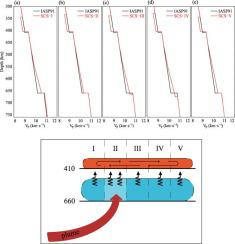当前位置:
X-MOL 学术
›
J. Asian Earth Sci.
›
论文详情
Our official English website, www.x-mol.net, welcomes your
feedback! (Note: you will need to create a separate account there.)
P-wave velocity anomalies atop and in the mantle transition zone beneath the northern South China Sea from triplicated waveforms
Journal of Asian Earth Sciences ( IF 2.7 ) Pub Date : 2020-08-01 , DOI: 10.1016/j.jseaes.2020.104379 Wenlan Li , Rongqiang Wei , Qinghui Cui , Guohui Li , Yuanze Zhou
Journal of Asian Earth Sciences ( IF 2.7 ) Pub Date : 2020-08-01 , DOI: 10.1016/j.jseaes.2020.104379 Wenlan Li , Rongqiang Wei , Qinghui Cui , Guohui Li , Yuanze Zhou

|
Abstract Broadband P waveforms from the China Digital Seismograph Network are used to image velocity structures of the mantle transition zone (MTZ) and lowermost upper mantle beneath the northern South China Sea. The study area is divided into five profiles from southwest to northeast with an azimuthal interval of 10°, and the best-fit 1-D velocity models are obtained from the observed and synthetic triplicated waveform fitting based on an iterative grid-search procedure. Relative to the Earth model IASP91, our results reveal that there are ubiquitous high-velocity anomalies (HVAs) in the lower part of the MTZ with the P-wave velocity increment of 1.5–3.5% and thickness of 209–219 km. The HVAs show no apparent progressive velocity increments or decrements along the southwest-northeast direction. Combining with previous seismological studies, we suggest that the HVAs provide an implication for the proto-South China Sea north slab remnants. The slight 5 km uplift of the 410 km discontinuity and 5–15 km depression of the 660 km discontinuity further support the low-temperature anomalies related to slab remnants stagnated in the MTZ. We also find a low-velocity layer (LVL) atop the MTZ with a P-wave velocity decrement of 2.0–2.5% and a thickness of 60–75 km, and the LVL can be interpreted by the partial melting induced by upwelling MTZ materials, which are hydrated by the water released from stagnant slab. We infer that small lateral variations of the LVL is relevant to the percolation of the melts under vertical pressure in the mantle.
更新日期:2020-08-01











































 京公网安备 11010802027423号
京公网安备 11010802027423号